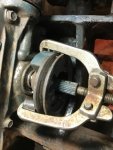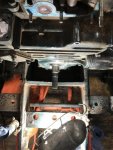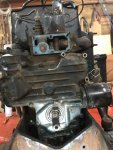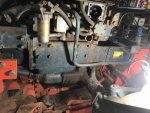All the engine and dynamo work is completed and after running the old oil and filter for about 15 minutes, I changed it all out to new.
However, I have a
major problem: in while attempting to drive in the new front bushing on the front axle for the new pivot pin, I noticed that the top of the bore in the casting is cracked, up to the backstop land on the inside of the bore; in other words, what would be the length of the bushing.
It is possible this is my fault, since I think it would have been better to have pulled the bushing in with a long threaded rod with a nut and washers, than try to pound it in with a hammer. I don't think I was hitting it exactly square because of the tie rod being a little in the way.
The bushing and the bore is a
very tight fit, as I recall from trying to remove them with a punch. Maybe just a little bit too tight?
My plan is use some nickel alloy cast iron welding rod and fix it. With the edge of a grinding wheel on my hand grinder, I will groove-out the crack from the top about half way down the thickness of the casting.
I am concerned primarily with getting a good structural repair. The area is not under any oil pressure. The bore just needs to hold the bushing and give a decent seal on the inside for the pivot pin.
Update: I have thought about this for a couple hours and have a plan!
I have concluded that Kubota's interference on the pivot pin bushings-to-housing bore is
insanely too much. They fit so tightly that an outer o-ring should not even be necessary!
I am still going to weld up the crack, but I am not going to worry about penetrating all the way to bore with the weld; I just want to make the housing strong and stop the crack. I don't have a way to re-machine the bore if I welded down to the inside.
After the welding, I will clearance both bores with a sandpaper flap wheel so that the bushing will tap in, not have to be beaten in. For the cracked bore, I'll remove the outer o-ring on the bushing and use seal retainer anaerobic sealant to set it on the bore. That way, there will be no way oil can seep out the crack from the inside.
For the other bushing, I'll clearance the bore, too, for less of an interference fit. However, I'll install it normally, keeping the outer o-ring.
Result:
I cut out a groove in the axle housing with a metal cutting wheel on my hand grinder. From the inside of the housing bore, I could see that the crack ended at the backstop for the bushing, so on the outside of the housing, I went back that far with the groove. At the bore entrance, I went deeper with the groove, nearly all the way through.
This shows the beginning of the groove. I went down to the bore, in the front, to get complete penetration there:
After blocking the rears of the bores with a round washer with the center taped, I used a Dremel sandpaper flap wheel to add clearance to the bore. I did a few test installs with one of the old bushings. I wanted it to tap in with the mallet, not beat in.
Welding finished:
After cleaning everything up with brake cleaner, and grinding the weld on the housing smooth, I installed the front bushing with Permatex anaerobic sleeve retainer, without the outer o-ring installed.
I installed the rear bushing normally. Lubed both the insides of the bushings and the pivot pin with moly grease.
One thing to remember is that the plate steel carriage must go on the axle first; otherwise, the oil pan will be in the way of inserting the pivot bolt if you try to mount the carriage on the block.
So that is about it. All these problems started by a tiny, missing oil galley plug.
One more thing, I noticed that when the oil filter is removed, the oil dribbles into the flat area of the carriage underneath the crankshaft pulley. There was a ton of gook there when I first pulled it off, now I know where it came from. The area does not clean itself. I'll have to put a piece of sheet metal under the filter next time I change it.
Copper washer on the oil plug is M12.











